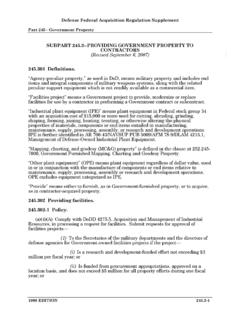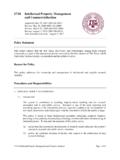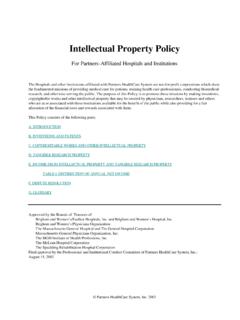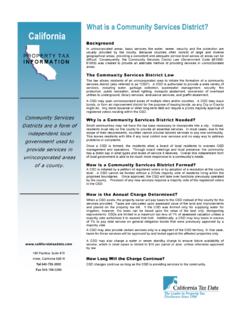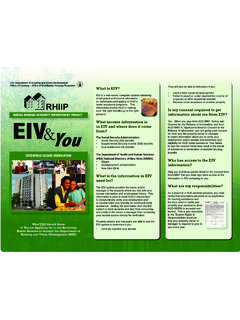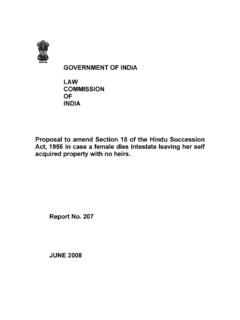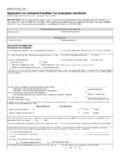Transcription of Property–Casualty Insurance Basics - aiadc.org
1 property Casualty Insurance BasicsRISK claimProtectionpremiuminvestmentReseRves olvencyunder-writingregulationpolicy-hol derA look inside the Fundamentals and Finance of property & Casualty InsuranceEvery day, individuals and businesses face a variety of potentially catastrophic risk and uncertainty. By creating tools to manage uncertainty and loss, property -casualty insurers are able to provide vital personal and professional protection. In addition, property -casualty Insurance helps provide and maintain a reliable foundation for our economy. Despite the fundamental role property -casualty Insurance plays in the lives of virtually every American, relatively few people outside of the Insurance industry understand how it works. This booklet looks at the basic concepts of property -casualty Insurance , providing a plain-English primer on several key topics.
2 We ll also look at Insurance finance by discussing how premiums are determined and tracing the path of the premium dollar as it flows through a hypothetical consumer and worker safety: Insurance makes businesses and individuals more aware of the risks they face and provides motivation to prevent losses. For example, insurers provide premium discounts to safe drivers and to businesses that implement effective worker safety consumer transactions: Most consumers have to borrow money to buy homes and cars; lenders require Insurance in order to secure the loans they make for these purchases. Without Insurance , few people could obtain an auto loan or home business transactions: Without Insurance , most businesses would find that they could not operate. Insurance enables businesses of all sizes and types to manage the risks that are an inherent part of any business operation ( , signing contracts, financing and expanding operations, manufacturing and distributing products, providing services, hiring employees).
3 Providing recovery from catastrophes: Hurricanes, winter storms, fires, and other disasters can cause tremendous, sudden loss to many people all at once. Insurance coverage enables businesses to replace inventories and reconstruct buildings, and allows homeowners to repair and rebuild homes and replace personal trillions of dollars to the economy each year:The property -casualty Insurance industry pays out more than $400 billion annually in policy insurers doing business in the United States have more than $ trillion invested in the economy, through stock, corporate and government bonds, and real estate investments finance building construction and provide other crucial support to economic development projects all across the insurers are a major source of capital for state and local government in the United States. Insurers invest, through municipal bonds, in a variety of public projects, such as airport, hospital, and highway construction.
4 Insurers also purchase general obligation bonds used to finance ongoing government are approximately 2,700 companies providing property -casualty Insurance coverage in the United States. About million people are employed by the property -casualty industry, including Insurance companies, agencies, and Benefits Society and the EconomyRisk is inevitable in society; Insurance helps address that reality. Insurance allows individuals and organizations to exchange the risk of a large loss for the certainty of smaller periodic payments, known as premiums. The exchange (or transfer) of risk is laid out in a legal contract called the Insurance policy, which spells out the coverage, compen-sation, and/or other takes on (or assumes) pure risk the possibil-ity of suffering harm or loss. ( Insurance is not for specula-tive risks, like gambling, where financial gain is possible.)
5 If a covered loss occurs, the policyholder is compensated consistent with the terms of the policy. Examples of risk covered by Insurance include fire, theft, tornadoes, mo-tor vehicle crashes, and being sued for causing harm to another person. Risk has two key dimensions frequency and severity and both help determine insurability. Frequency relates to how often a loss occurs, , whether the risk/event is common or relatively rare. Severity relates to how costly losses resulting from that risk could be, , whether they could be relatively inexpensive or truly catastrophic in shown in the table on the right, Insurance is an appro-priate method of risk transfer for low-frequency, high-severity losses ( , house fires or tornadoes), as well as for high frequency, low severity losses ( , motor vehicle crashes). However, Insurance may not be the most ap-propriate method for treating all risks facing individuals and businesses.
6 For example, Insurance could be too expen-sive for certain risks (such as low-frequency, low-severity) or unavailable for other risks (such as high-frequency, high-severity risks, or risks whose frequency and/or sever-ity is difficult to predict, such as terrorism). Additionally, Insurance may be unable to fully compensate for a loss ( , the destruction of family photos, which have great emotional value, but little financial value). property -Casualty BasicsInsurance Helps People Manage RiskLow Frequency High SeverityHigh Frequency High SeverityLow Frequency Low SeverityHigh Frequency Low SeverityFreqUenCySeverITyIn taking on massive amounts of societal risk, the insur-ance industry relies on two fundamental tools: pooling and the Law of Large Numbers. An insurer can cover the risk of losses from a few policyholders by combining (pool-ing) together the premiums from a much larger group of policyholders.
7 This also improves predictability, thanks to a statistical principle known as the Law of Large Numbers, which states that the accuracy of loss prediction increases with the number of policyholders in the pool. Insurance also handles risk by working to prevent losses to lives and property . Loss prevention (also known as loss control or mitigation), is a core function of the Insurance business and has benefited society immeasurably. The Fundamentals and Finance of property & Casualty Insurance 1 property -casualty Insurance traces its modern history back to marine Insurance in the late Middle Ages. With an increase in maritime trading, merchants and bankers became concerned about the safety of shipments due to piracy, storms, and other perils. The bankers provided guarantees against loss; in return, merchants paid the bankers a fee for this protection.
8 Fire Insurance , and what became the modern Insurance industry, developed primarily in England after the Great London Fire in 1666. The property -casualty Insurance market evolved from British practices, with the first fire insurer started by Benjamin Franklin in 1752. By the early 1900s, many major types (or lines ) of Insurance we know today had developed. Today, this segment of the Insurance industry provides pro-tection from risk in two basic areas: protection for physical items, such as houses, personal possessions, cars, com-mercial buildings, and inventory ( property ), and protection against legal liability (casualty). property Insurance is a first-party coverage. It provides for losses re-lated to a policyholder s own person/ property . Casualty/Liability Insurance is a third-party coverage. It provides protection for a policyholder against the claims of others.
9 These two basic types of cover-age are written for both individuals or families ( personal lines policies) and businesses ( commercial lines policies). Personal lines policies include home-owners Insurance , renters Insurance , and vehicle coverage. For example, homeowners policies cover both fire Origins and Typesdamage to a house and/or contents, plus legal defense costs and liabilities should a person be injured on the poli-cyholder s property . Commercial lines products are written for businesses and other organizations (churches, schools, cities, non-profits), and include packages such as Business Owners Policies as well as commercial general liability, workers compensa-tion, commercial property , and product liability Insurance . Commercial property policies cover buildings and the organization s property . It may include coverage known as business interruption, designed to help a company with business losses that result from a covered risk to property .
10 Commercial liability policies protect policyholders against fi-nancial responsibility for injury or property damage resulting from a policyholder s premises, products, services, or other operations. One example of commercial casualty coverage is workers compensation, which deals with lost earnings and medical expenses of employees injured on the job. The specific scope and limits of coverage in all of these examples is spelled out by an individual Insurance policy. Interestingly, today s Insurance policy-related transactions still look much like those of prior centuries the Insurance underwriter reviews a particular risk and determines whether, and on what terms, to pro-vide Insurance modern Insurance industry, developed primarily in England after the Great London Fire in Insurance2 American Insurance AssociationProperty-Casualty InsuranceProperty-casualty Insurance is heavily regulated at the state level.


